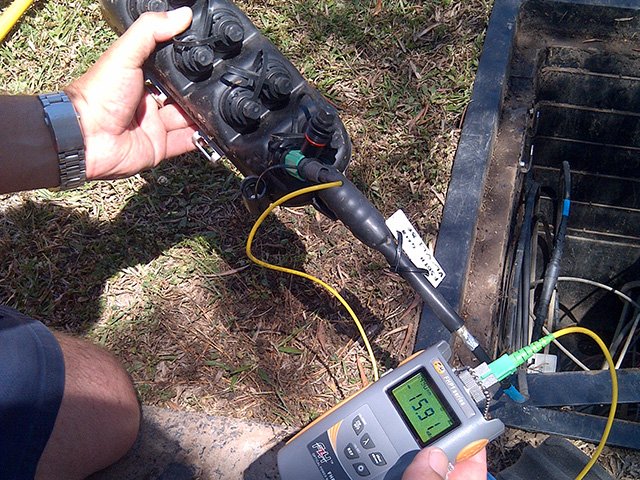Checking Out the Advantages of Optical Fibre Testing for Improved Interaction Solutions
The importance of optical fiber screening in contemporary communication systems can not be overstated, as it offers as a foundation for making certain network integrity and efficiency. This aggressive testing technique has profound effects for signal high quality and functional performance, elevating the question of exactly how these practices contribute to long-term sustainability in an ever-evolving technological landscape.
Significance of Optical Fiber Screening
The importance of optical fiber screening can not be overemphasized in today's data-driven environment. As companies increasingly rely upon high-speed information transmission for daily operations, the integrity and efficiency of optical fiber networks are extremely important. Checking guarantees that these networks can support the substantial quantities of information created and sent seamlessly, fostering effective communication and connection.
Optical fiber testing offers numerous important features, consisting of validating installment high quality, identifying prospective faults, and determining overall system efficiency. Regular testing can protect against expensive downtimes and solution interruptions, allowing companies to keep operational continuity. Furthermore, it aids in conformity with sector requirements and laws, guaranteeing that fibre optic installments fulfill needed specifications for security and integrity.
Additionally, screening can boost the longevity of fibre optic systems. By proactively identifying concerns such as signal loss, depletion, or adapter failures, companies can address issues before they escalate, thus prolonging the life of their framework. In summary, optical fibre screening is not merely a technical demand yet a tactical investment that enhances network reliability, enhances efficiency, and ultimately sustains the development and performance of modern-day communication systems.
Key Examining Methods

OTDR is a vital strategy made use of to identify faults, action splice losses, and examine the general integrity of a fiber optic link. By sending out a pulse of light down the fibre and evaluating the shown light, professionals can determine locations of faults and review the network's efficiency over long distances.
Insertion loss screening gauges the amount of signal loss that takes place when light passes with a connection or splice. This method is essential for validating that links meet given loss limits, which is necessary for maintaining optimal performance in communication systems.
Optical return loss testing measures the amount of light mirrored back in the direction of the source as a result of blemishes in the fiber or connections. High return loss values show far better more tips here efficiency and lowered signal degradation.
Together, these testing approaches give an extensive analysis of fiber optic networks, guaranteeing their reliability and capability in varied interaction applications.
Effect On System Performance
Reliable optical fiber testing straight influences the general performance of communication systems. By making certain the stability of fibre optic cable televisions, testing identifies prospective mistakes such as depletion, splice loss, and connector misalignment. These issues can dramatically weaken signal high quality, resulting in disruptions and lowered data transmission rates.

Furthermore, normal optical fiber testing adds to lasting system sustainability. It allows very early discovery of deterioration, enabling prompt maintenance and upgrades before major failings take place. This not just lengthens the lifespan of the infrastructure but likewise guarantees that communication systems stay affordable in regards to performance.
Cost-Effectiveness and Effectiveness
Cost-effectiveness is a critical factor to consider in the release and upkeep of optical fibre networks. Executing robust optical fibre screening procedures can substantially lower operational prices by identifying concerns prior to they intensify into significant issues. optical Homepage fibre testing equipment. By identifying faults, attenuation, and various other performance barriers early, organizations can stay clear of expensive repair services and downtime, which can interrupt solutions and result in earnings loss
Additionally, effective testing methodologies simplify the setup process, allowing technicians to function much more effectively. This translates to decrease work costs and faster task completion times. Advanced screening equipment, such as Optical Time Domain Name Reflectometers (OTDRs), enables a precise analysis of fibre quality, making sure that only optimal products are made use look at here now of, therefore reducing waste.
Normal screening also adds to much better resource allocation. By recognizing the network's efficiency, companies can make educated choices regarding upgrades and developments, guaranteeing that financial investments are made where they are most needed. In summary, optical fiber testing improves cost-effectiveness and effectiveness, sustaining the long-term sustainability and competitiveness of interaction systems in an increasingly demanding market.
Making Certain Long-Term Dependability
Implementing extensive optical fiber testing not only improves price savings and operational effectiveness yet also plays an essential duty in ensuring the long-term dependability of interaction networks. Consistent testing techniques, consisting of depletion and data transfer analyses, help determine possible destruction in fibre performance before it causes solution interruptions.
By utilizing advanced testing methodologies, network drivers can determine mistakes or weak points in the fiber infrastructure, enabling prompt remediation. This proactive method lessens downtime, making certain that interaction systems stay useful and reliable. Moreover, normal testing adds to the growth of an extra resistant network, as operators can adjust and maximize their facilities based upon real-time data understandings. fibre testing equipment.
Additionally, ensuring conformity with market standards via optical fiber testing reinforces the high quality and integrity of the entire interaction system. This adherence not just strengthens confidence amongst stakeholders yet likewise straightens with regulative demands, which are significantly rigid.
Verdict
In conclusion, optical fibre testing serves as a fundamental component in improving communication systems. By utilizing different testing approaches, such as OTDR and insertion loss assessments, networks can achieve optimal efficiency and integrity.